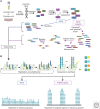Genome-Wide Sequencing for Prenatal Detection of Fetal Single-Gene Disorders
- PMID: 26253094
- PMCID: PMC4588135
- DOI: 10.1101/cshperspect.a023077
Genome-Wide Sequencing for Prenatal Detection of Fetal Single-Gene Disorders
Abstract
New sequencing methods capable of rapidly analyzing the genome at increasing resolution have transformed diagnosis of single-gene or oligogenic genetic disorders in pediatric and adult medicine. Targeted tests, consisting of disease-focused multigene panels and diagnostic exome sequencing to interrogate the sequence of the coding regions of nearly all genes, are now clinically offered when there is suspicion for an undiagnosed genetic disorder or cancer in children and adults. Implementation of diagnostic exome and genome sequencing tests on invasively and noninvasively obtained fetal DNA samples for prenatal genetic diagnosis is also being explored. We predict that they will become more widely integrated into prenatal care in the near future. Providers must prepare for the practical, ethical, and societal dilemmas that accompany the capacity to generate and analyze large amounts of genetic information about the fetus during pregnancy.
Copyright © 2015 Cold Spring Harbor Laboratory Press; all rights reserved.
Figures

Similar articles
-
Whole-Exome Sequencing and Whole-Genome Sequencing in Critically Ill Neonates Suspected to Have Single-Gene Disorders.Cold Spring Harb Perspect Med. 2015 Dec 18;6(2):a023168. doi: 10.1101/cshperspect.a023168. Cold Spring Harb Perspect Med. 2015. PMID: 26684335 Free PMC article. Review.
-
The current and future impact of genome-wide sequencing on fetal precision medicine.Hum Genet. 2020 Sep;139(9):1121-1130. doi: 10.1007/s00439-019-02088-4. Epub 2019 Nov 21. Hum Genet. 2020. PMID: 31754893 Free PMC article. Review.
-
[Ways to improve prenatal diagnosis of chromosome abnormalities and congenital defects of fetal development].Akush Ginekol (Mosk). 1990 Jan;(1):16-8. Akush Ginekol (Mosk). 1990. PMID: 1693812 Russian. No abstract available.
-
Beyond screening for chromosomal abnormalities: Advances in non-invasive diagnosis of single gene disorders and fetal exome sequencing.Semin Fetal Neonatal Med. 2018 Apr;23(2):94-101. doi: 10.1016/j.siny.2017.12.002. Epub 2018 Jan 2. Semin Fetal Neonatal Med. 2018. PMID: 29305293 Review.
-
[Medical genetics and the genome].Ugeskr Laeger. 2014 Nov 10;176(46):V06140361. Ugeskr Laeger. 2014. PMID: 25394930 Review. Danish.
Cited by
-
Attitudes toward uncertain results from prenatal exome sequencing: a national survey among healthcare professionals working in the prenatal setting.Front Med (Lausanne). 2024 May 15;11:1335649. doi: 10.3389/fmed.2024.1335649. eCollection 2024. Front Med (Lausanne). 2024. PMID: 38813373 Free PMC article.
-
Fetal gene therapy.J Inherit Metab Dis. 2024 Jan;47(1):192-210. doi: 10.1002/jimd.12659. Epub 2023 Aug 7. J Inherit Metab Dis. 2024. PMID: 37470194 Review.
-
Whole-exome sequencing in deceased fetuses with ultrasound anomalies: a retrospective analysis.BMC Med Genomics. 2023 Feb 16;16(1):25. doi: 10.1186/s12920-022-01427-1. BMC Med Genomics. 2023. PMID: 36797717 Free PMC article.
-
Genetics in prenatal diagnosis.Singapore Med J. 2023 Jan;64(1):27-36. doi: 10.4103/singaporemedj.SMJ-2021-433. Singapore Med J. 2023. PMID: 36722514 Free PMC article. Review.
-
How to choose a test for prenatal genetic diagnosis: a practical overview.Am J Obstet Gynecol. 2023 Feb;228(2):178-186. doi: 10.1016/j.ajog.2022.08.039. Epub 2022 Aug 24. Am J Obstet Gynecol. 2023. PMID: 36029833 Free PMC article.
References
-
- ACOG. 2013. Committee Opinion No. 581: The use of chromosomal microarray analysis in prenatal diagnosis. Obstet Gynecol 122: 1374–1377. - PubMed
-
- Alamillo CM, Fiddler M, Pergament E. 2012. Increased nuchal translucency in the presence of normal chromosomes: What’s next? Curr Opin Obstet Gynecol 24: 102–108. - PubMed
-
- Atwal PS, Brennan ML, Cox R, Niaki M, Platt J, Homeyer M, Kwan A, Parkin S, Schelley S, Slattery L, et al. 2014. Clinical whole-exome sequencing: Are we there yet? Genet Med 16: 717–719. - PubMed
Publication types
MeSH terms
LinkOut - more resources
Full Text Sources
Other Literature Sources
Medical
